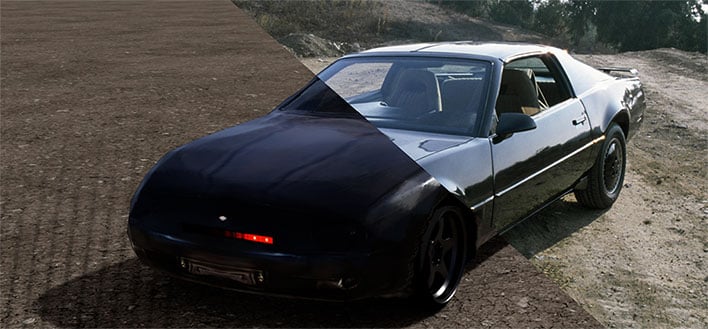Knight Rider's KITT Virtually Recreated To Patrol The Shadowy Streets Of NVIDIA Omniverse
NVIDIA has been able to do some incredibly cool things with its efforts in artificial intelligence and machine learning, like make a Photoshop filter that can instantly age and transform faces. Ranking right up there, however, is bringing Knight Rider's KITT-infused ride to life in the NVIDIA Omniverse, an open platform built for virtual collaboration and real-time psychically accurate simulation.
That in and of itself is noteworthy—few cars are as iconic as the 1982 Pontiac Firebird Trans Am equipped with KITT (Knight Industries Two Thousand), the highly advanced AI computer module that was always helping Michael Knight (played by David Hasselhoff) out of jams. Not traffic jams (well, those too), but life and death situations.
If you watched the show, you can probably hear KITT's voice in your head, and who can forget the light strip on the front of the car? For geeks like us, it's the perfect, um, vehicle to showcase NVIDIA's new deep learning engine powering its GANverse3D application, which can take a standard 2D image (or a series of images) and create a 3D object model.
NVIDIA generated a dataset for training using a GAN (generative adversarial network) to synthesize images from the same object, from different viewpoints. It's akin to a photographer walking around a car and snapping photos from different sides and angles. Those images were then plugged into a rendering framework for inverse graphics to train its GANverse3D application.
"Because we trained on real images instead of the typical pipeline, which relies on synthetic data, the AI model generalizes better to real-world applications," said NVIDIA researcher Jun Gao, an author on the project.
Bringing KITT to life is a fun way to showcase the technology, but there are bigger plays at hand. As NVIDIA points out, creators do not always have the time or resources to create 3D models of all the objects they sketch. And to try and capture multiple views of, say, a showroom full of cars, a creator would be looking at a hefty investment. GANverse3D is a potentially useful end-around.
"Omniverse allows researchers to bring exciting, cutting-edge research directly to creators and end users," said Jean-Francois Lafleche, deep learning engineer at NVIDIA. "Offering GANverse3D as an extension in Omniverse will help artists create richer virtual worlds for game development, city planning or even training new machine learning models."
It's not clear when this extension will be widely available. In the meantime, NVIDIA plans to talk about the research driving GANverse3D at a couple of upcoming technology conferences.



